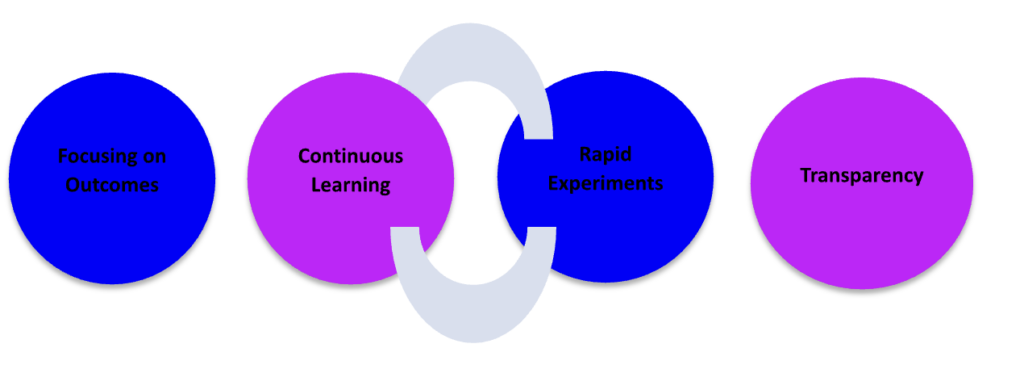
Product development is evolutionary! New prioritization frameworks popping up every week, a new competitor feature that just launched, or an idea generated during your sweet nap time can hamper your ability to stick to a roadmap which was well crafted 6 months ago. To plan an escape from this vicious cycle and engage in re-prioritization we product managers can sometimes become too rigid with our product roadmaps, even becoming a cause of our own misery.
Product roadmaps are often seen as the holy grail of planning and execution. They provide a sense of direction, help align teams, and give stakeholders a clear view of what's coming next. They serve as a guiding light for executive leaderships to manage and develop forecasts on resourcing and fill the funding winter if it comes! However, when product managers cling too tightly to these roadmaps, they risk stifling innovation, missing market opportunities, and ultimately, killing their product. This article explores why flexibility in product planning is crucial and presents a framework for striking the right balance between structure and adaptability.
The allure and pitfalls of rigid roadmaps
It's easy to understand why we product managers might be tempted to stick religiously to our roadmaps:
- Predictability: A fixed roadmap provides a clear timeline and set of deliverables, So, we do not need to forecast as often and re-plan milestones to bring the roadmap variance within control limits.
- Resource allocation: When plans are set in stone, it's simpler to allocate resources and budget. Also, succession management planning (SMP) can be easier if we are aware of the next delivery along with knowing who needs to be backfilled.
- Stakeholder management: A detailed roadmap can be a powerful tool for keeping stakeholders informed and aligned, Also, reducing the need of communication and re-communication.
However, in my experience, this rigidity comes at a significant cost. Let's examine the four key issues with rigid product roadmaps:
1. Market misalignment
Markets evolve rapidly. New competitors emerge, customer preferences shift, and technologies advance. A rigid roadmap can blind you to these changes, causing you to build features that may have been relevant when you planned them but are obsolete by the time they're released.
During the course of my existing engagement in running a B2B product development, there was a radical shift in compliance requirements from the regulatory agencies, leading to accommodation of a critical reporting feature, if not done, it would have led to a big compliance risk. I acknowledged that if the product roadmap was not pivoted to cater to these immediate needs we may be looking at huge fines in a year’s time.
Regulatory situations cannot always be forecasted; hence Product Managers are required to instrument their roadmap plan to accommodate uncertainties.
Industry case study: Meta's horizon worlds (2022-2023)
Meta (formerly Facebook) heavily invested in the metaverse (Zuckerberg’s new gig), particularly its virtual reality platform Horizon Worlds, believing it to be the next big tech frontier, However, the market was misread, the product failed to align with current market demand and user expectations.
Outcome:
- Meta's stock price dropped by over 60% in 2022, With user adoption of only 200K monthly active users as opposed to a 500k prediction.
- The company's metaverse division, Reality Labs, reported losses of $13.7 billion in 2022.
2. Innovation stifling
When teams are too focused on delivering pre-planned features, they may miss opportunities for creative problem-solving or breakthrough ideas that could dramatically improve the product. Innovation often comes from unexpected places, and rigid roadmaps leave little room for exploration.
Though, being careful with innovation to not hamper the time to release is also important, it’s all about striking the right balance!
Industry Case Study: Intel's Chip manufacturing delays (2022-2023)
Intel, once a leader in semiconductor manufacturing, fell behind competitors due to delays in developing new chip technologies, Internal bureaucracy and a focus on existing technologies stifled innovation in advanced chip manufacturing processes.
Outcome:
- Intel's market share in the server processor market dropped to 75.9% in 2024, down from 90.4% in Q3 2020.
- The company's stock price decreased by about 55% from its peak in 2020 with a reported net loss of $1.61 billion.
3. Resource inefficiency
Sticking to outdated plans means investing time and money into features that may not provide value. This inefficiency can be costly, especially for start-ups and small companies with limited resources.
Case in point was my time at leading product development for a ML and data science augmentation project, where resources were being trained on-the-job, hence, sticking to training plans which were relevant to feature developments which were discovered and deemed relevant six months ago were no longer relevant and may even interject with productivity if followed.
Industry case study: Amazon's Alexa division (2022)
Amazon heavily invested in its Alexa voice assistant technology, believing it would drive significant revenue through voice shopping and other services, Though, the division struggled to monetize per projections leading to layoffs in the space. Despite having over 100 million Alexa-enabled devices sold, only a small percentage of users made purchases through voice commands
Outcome:
- Amazon's Alexa division reportedly lost around $10 billion in 2022.
- The company announced layoffs of approximately 10,000 employees in late 2022, with a significant portion from the Alexa team.
4. Team demotivation
Talented product developers and engineers thrive on solving real problems. If they're forced to work on features they know are no longer relevant or valuable, it can lead to frustration and decreased motivation. Everyone likes to be creative at times, if the creative space is taken out of the metric, demotivation sulks in faster than expected!
Industry case study: Twitter's mass layoffs and policy changes (2022-2023)
Following Elon Musk's acquisition of Twitter, the company underwent dramatic changes in leadership, policies, and workforce, with rapid policy shifts, mass layoffs, and public disputes in play, employee motivation went to an all time low, with flurry of organic and inorganic attrition.
Outcome:
- Twitter's workforce was reduced by approximately 80%, from 7,500 employees to about 1,500 in early 2023.
- Ad revenue reportedly dropped by 40% year-over-year in December 2023.
Let’s explore my proven approach to developing the roadmap
The FLEX Roadmap Model
To address these issues and implement solutions which can deliver quick fast and can scale, Over the years I developed my own FLEX Roadmap Model:
F - Focus on outcomes
L - Learn continuously
E - Experiment rapidly
X - X-ray vision (transparency)

Let's explore each component of this model and how it can be implemented:
1. Focus on outcomes
Instead of detailing specific features months in advance, organize your roadmap around themes or high-level objectives. This approach provides direction while allowing flexibility in how you achieve your goals.
The solution will become easier if you as a product manager can take proactive steps in coaching your leadership teams on Rolling-Wave planning.
High level focus areas:
- Define clear, measurable objectives rather than specific features.
- Use OKRs (Objectives and Key Results) to guide product development.
- Set a well-defined long-term vision for your product to serve as a north star, guiding decisions even as short-term plans change.
- Continuously advocate and voice opinions in favour of evolving plans, remember over communication is a good thing!
Implementation:
Step 1: Feature breakdown
1.1 Develop a high level view on product strategy
1.2 Compartmentalize your product strategy into product focus areas
1.3 Break product focus areas into product features
Step 2: Release planning
2.1 Proceed with Rolling wave planning as ideas on product features become clear
2.2 Start execution through ‘Feature driven development’

2. Learn continuously
At some point we have all been hostages to a stringent deadline, immediate needs of accommodating priority and dry Microsoft Project Plans, dreading to update those plans and convincing executives on why the updates are not clearly documented can be taxing! Here, agile comes to your rescue!
(Agile by design advocates continuous improvements and continuous feedback loops, Agile also promotes failing early, your Definition of Done can change and evolve, hence, keep making changes to your DoD as your product development continues and expands and you collect more and more feedback)

Hence, as a product manager your starting point should be to create formal channels for collecting and analyzing customer feedback and enabling a smooth window to augment those feedbacks into your development, once you can achieve this, you will have a solid reasoning for ‘Why the plan needs to change?’
Always, make it a priority to incorporate customer input into your roadmap decisions and share the roadmaps as frequently as possible; Even better, set up a fortnightly, roadmap review call to maintain transparency, it has always worked flawlessly in my case, and there’s no reasoning why it shouldn’t work for yours!
High level focus areas:
- Establish regular feedback loops with customers and stakeholders.
- Conduct market research and competitor analysis on an ongoing basis.
- Use metrics and data to guide your product decisions. Over communicate these metrics to your leadership and stakeholders to overcome resistance at a later stage.
Implementation:
Step 3: Delivery methodology
3.1 Establish full scale Agile framework on your product delivery by advocating
- Daily scrum
- Sprint planning and backlog grooming
- Incremental product demonstrations
- Sprint retrospectives for feedback collection
3.2 Setup an achievable definition of done early on to avoid last minute surprises
Step 4: Metrics visualization
4.1 Use metrics and dashboards to validate your product decisions focussing majorly on feature importance, feature touchpoints.
4.2 Ensure to develop these metrics in collaboration with your customers and product teams to capture the most accurate results.
Intelligent fact: Do you know only 6% of the product features are actually ever used regularly by your customers as part of their customer journey?
3. Experiment rapidly
While sticking to pre-defined agenda and objectives is necessary, most value is created when teams experiment and fail. As a product manager I have always encouraged my team to run small experiments and develop alternate prototypes.
Building a reward structure and healthy competition can lead to exceptional results, experimentation also helps validate assumptions before committing significant resources to a feature.
(Try using Six Thinking Hats and 5 Whys concept to assess right experimentation and driving clarity)

High level focus areas:
- Your development cycles should be tailored to accommodate discovery and delivery together, it’s ok to complete a sprint without delivering anything as long as your discovery is on point!
- Use techniques like A/B testing and minimum viable products (MVPs) to validate ideas quickly.
- Allow for some unallocated time in your roadmap. This can be used for addressing unexpected issues, incorporating new ideas, or adapting to market changes.
Implementation:
Step 5: Enabling experimentation
5.1 Allocate specific time (~10%) in each sprint for your team to collectively brainstorm on ideas and refine generated ideas
5.2 Enable idea plotting to capture themes and pick top three ideas for implementation in subsequent delivery
Step 6: Conducting validation
6.1 Validate the implemented ideas through release in a small subset, thus enabling consumer experimentation
6.2 Swiftly discard unused ideas (features) which do not pull in positive outcomes (financial/user experience) within first 60 days
4. X-ray vision (transparency)
I think 70% of the product manager’s job revolves around driving clarity, fostering clarity amidst uncertain and ambiguous environments is a mountain in itself. When the objective is unclear and ideas are floating all over the place, bringing in a structure and a ‘How to’ guide makes a huge impact!

When you do need to adjust the roadmap, be transparent about the reasons with your team, drive transparency through guidelines by pointing towards the incremental value and enable collaborative sessions! (MIRO works best here)
This will help stakeholders understand the value of flexibility, eventually augmenting your roadmap with achievable product's overall goals.
High Level Focus Areas:
- Maintain a visible, easily accessible roadmap for all stakeholders.
- Conduct regular review sessions to discuss changes and gather input.
- Schedule frequent (e.g., monthly or quarterly) roadmap reviews. Use these sessions to assess progress, evaluate market changes, and adjust plans as needed.
- Facilitate digital information radiator for your stakeholders to review and comments eventually fostering collaboration
Implementation:
Step 7: Inviting review
Step 7.1: Use custom or standard templates to conduct monthly product performance review focussing on user base and financial metrics
Step 7.2: Close changes and document release notes formally month on month
Step 8: Product release
Release your product roadmaps in your product circle and consumer base enabling positive user experience and product acceptance
Striking the right balance
It's important to note that abandoning structure entirely is not the answer. The key is to find a balance between providing direction and maintaining flexibility.
- Use time horizons: Divide your roadmap into different time horizons. Near-term plans can be more specific, while long-term plans should be more flexible and theme-based.
- Focus on outcomes, not output: Instead of promising specific features, commit to achieving certain outcomes or solving particular problems. This gives your team the freedom to find the best solutions.
- Build in buffer time: Allow for some unallocated time in your roadmap. This can be used for addressing unexpected issues, incorporating new ideas, or adapting to market changes.
- Continuously communicate: Keep all stakeholders informed about the evolving nature of the roadmap. Help them understand that changes are a sign of responsiveness, not instability.
In summary
While roadmaps are valuable tools for product development, they should be viewed as living documents rather than inflexible mandates. By embracing the FLEX Roadmap Model you're not just saving your product – you're setting it up to thrive in an ever-changing market landscape.
Remember, the most successful products are often those that can adapt quickly to change. By loosening your grip on rigid roadmaps and implementing a more agile approach to product planning, you ensure that your product remains relevant, competitive, and truly valuable to your customers.









Comments
Join the community
Sign up for free to share your thoughts